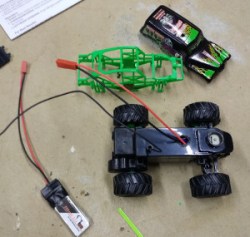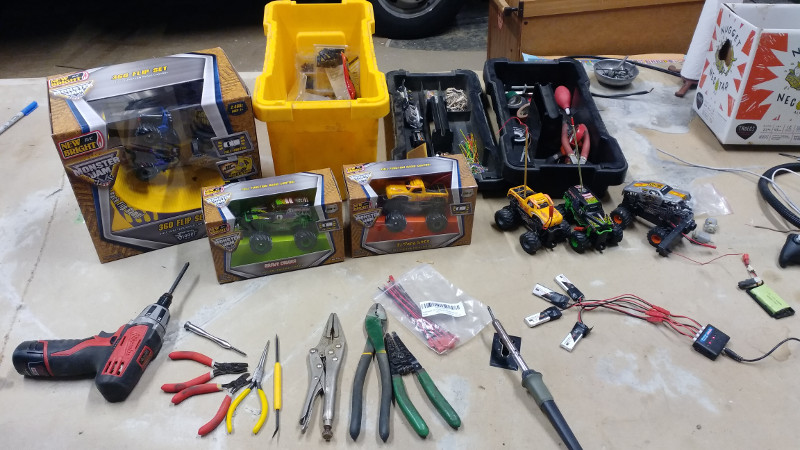The world of RC can be neatly split into two separate groups: models and toys. The RC models are generally big, complex, and as you’d imagine, more expensive. On the other hand, the RC toys are cheap and readily available. While not as powerful or capable as their more expensive siblings, they can often be a lot of fun; especially since the lower costs means a crash doesn’t put too big of a ding into to your wallet.
With his latest mod, [PoppaFixIt] has attempted to bridge the gap between toy and model by sticking a considerably overpowered battery into a $10 RC truck from Amazon. He reports greatly improved performance from his hacked together truck, but anyone looking to replicate his work should understand the risks before attempting to hack up their own version.
The principle is pretty simple; the truck is designed to run on two AA batteries, providing 3 volts. But by swapping the AAs out for a 3.7 volt 1S LiPo of the type that’s used in small airplanes and quadcopters, you can get an instant boost in power. As a happy side effect, the LiPo batteries are also rechargeable and fairly cheap, so you won’t have to keep burning through alkaline AAs.

The mod itself is a basic job that only requires a few bucks in parts, and for which [PoppaFixIt] has helpfully provided Amazon links. Essentially you just crack open the truck, solder a JST connector pigtail to the positive and negative traces on the PCB, and then pop a hole in the roof to run the new battery wires out.
Right about now the RC purists are probably screaming obscenities at their displays, and not without reason. As fun as these supercharged little trucks are to drive, there are a number of real issues here which need to be mentioned.
First, while the motor will probably be alright with a bit higher voltage running through them, the gears won’t be liking it one bit. In fact, [PoppaFixIt] even mentions they shredded a few gears when they tried to take one off-road. The second issue is that since these vehicles were not designed with LiPo batteries in mind, there’s no low voltage cutoff to prevent over discharge. If you aren’t careful, a setup like this will cook those cute little batteries in short order. But hey, at least it’s all cheap.
If you are more interested in control than power, you may want to check out the previous hacks we’ve featured. Seems like these little RC trucks are the platform of choice for hackers who want to get stuff moving on the cheap.
















Lithium battery protection boards cost a dime a dozen, so what?
> there’s no low voltage cutoff to prevent over discharge
Won’t the LiPo protection circuit prevent that? Otherwise whiskers might form and set the battery on fire the next time its charged.
The ones used for RC generally dont have protection circuits because they would rather ruin a battery than crash a model. But you can get little batteries with protection circuits from places like adafruit and amazon.
i don’t know personally, but i have been told that these low-voltage protection circuits are generally non-reversible. so it prevents fire but doesn’t prevent totaling the battery. ?
No protection circuit on most, if not all, RC hobby LiPo batteries.
once the voltage got low the RC gear would stop functioning corectly and the fun would come to end before the battery voltage drop to a disasterously low voltage. sure it could be left on for an extended period of time and flatten the batery that way but that would be your own fault
3.0V is deep discharge for a lipo, but it is the nominal voltage for this car. the user would probably notice the reduced performance, but the car wouldn’t actually stop going until the lipo is well past where we’d prefer it.
You are spot on. People regularly toast their batteries due to discharging their batteries too much.
I should have noted that the “people” I’m referencing are people in the RC hobby.
Exactly.
The truck will start slowing down when the batteries are getting critically low, but it won’t be so slow as to keep the user from using it unless they understand what’s going on. Good luck explaining to your kid that he has to stop driving his truck when he notices the slowdown; more often than not they’ll ride it right into the ground and then you’ve got a problem.
Now put a brushless motor in there and metal gearing, maybe toss an fpv cam on the front for some extra fun
Offroad cars are far too bouncy to just “toss” an FPV cam into. It would require more effort than it’s worth (for a casual hobbiest) to stabilize the camera well enough so you could actually see what’s going on. Although you’d probably have a significantly easier time with something large like an 1/8 or bigger. The suspension on the big cars is much more capable.
Hi All,
This is a bit of an aside but can anyone recommend a decent RC forum? I am thinking about getting into it (especially boats but all are game at this point).
As for the project featured, this is right up my alley and my kinda fun :)
rcgroups.com
Much appreciated :)
“Right about now the RC purists are probably screaming obscenities at their displays”
Probably not, most of them are probably cheering the inevitable destruction of a cheap crappy toy :-D
Unless of course you mean the OCD anal ones that will spec you out $5000 worth of gear as a bare minimum beginners setup.
Isn’t there some cheapass way to get some overdischarge protection? like putting diodes in series with a relay until you adjust it’s dropout voltage to close to where you want to be.
maybe look on ebay for something like
“1S PCB Protection Circuit for 3.7V 18650 Li-ion lithium LiPo Battery Cell BMS”
https://www.ebay.com/sch/i.html?_from=R40&_sacat=0&LH_BIN=1&_nkw=18650+protection+circuit&_sop=15
they are less than a dollar free shipping, at that price maybe is not work to develop a home solution.
Interesting…
I have a Chromebook with a “dead” battery. The cells are fine, it will take a charge, but as soon as it’s unplugged from the wall it just dies. I think the controller board has crapped out.
I wonder if I could replace the controller board – or, if I could salvage the LiPos from it, pair them with a charge controller, and re-use them in some other application (like RC cars).
was thinking about a z-diode but at less than a dollar a pop for “complete” protection even that’s probably not worth it…
You can also just get a low battery indicator buzzer.
In a (slightly) similar project I used 3Xnimh’s from an old phone to boost the motor voltage. I think I later got a lipo with charge/protection for less than the cost of the 3 NIMH’s
https://hackaday.io/project/5536-olduino-carbot-adapter-board
>>First, while the motor will probably be alright with a bit higher voltage running through them, the gears won’t be liking it one bit.
0.7V is probably less damaging than the massive available current increase (1-2A to 7A) you’ll get by switching battery chemistries.
That’s not much of an issue either unless they weight the truck down or hold the throttle while the wheels are stuck and unable to move.
“…voltage running through them”
ahum… do I really need to explain that this statement is evil and is not to be used by people claiming technical skills or putting it onto technical websites (like hackaday).
Voltage doesn’t run, current runs. Voltage is the cause of the running current. We don’t say that the pressure is running through the pipes, or do we (although I would not be surprised if there are people would be saying this, but you get my point).
I just could not resist in pointing this out.
Please don’t let this happen again.
Yes, think of the children, or at least the pedantic old farts with too much blood pressure running through their veins.
I’m wondering what actions [Jan] is going to take, if it does happen again…
Maybe you don’t, but it’s common for people to use “running” in combination with pressure and voltage. Even though neither molecules of gas nor electrons/holes have legs with which to run!
I’ve also ran wires even though I’ve never done slack-lining. Would you believe that! :)
NO LVC ???? Ebay $20 you can replace the ESC and motor and battery
LIPO
Brushless
Flying mini car that kills it self without flames
Using a low voltage buzzer is advisable if you use at least a 2S battery, but there are no buzzers for 1S batteries, and I really hate that.
All the Chinese protection boards have 2.5 V overdischarge protection, which is considered too low by majority of users. GreatScott has made a very nice protection/charging board with 3V cut-off threshold and good charging characteristics.
https://youtu.be/Fj0XuYiE7HU
Furthermore, I don’t like the idea of using Li based batteries in my kids toys, but there aren’t any NiMh protection/charging boards that I’m aware of. If you know some, please let me know.
stack some mosfetts on the board so you dont fry it. used to do that with my zipzpas and then hook up a 9v battery. 2 hour run time, 4times teh speed. fried a few suckers in the beginning stages before figuring to add mosfetts.